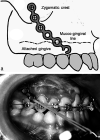New treatment modality for maxillary hypoplasia in cleft patients. Protraction facemask with miniplate anchorage
- PMID: 20482368
- PMCID: PMC8966454
- DOI: 10.2319/073009-435.1
New treatment modality for maxillary hypoplasia in cleft patients. Protraction facemask with miniplate anchorage
Erratum in
- Angle Orthod. 2012 Jul;82(4):754
Abstract
Objective: To present cleft patients treated with protraction facemask and miniplate anchorage (FM/MP) in order to demonstrate the effects of FM/MP on maxillary hypoplasia.
Materials and methods: The cases consisted of cleft palate only (12 year 1 month old girl, treatment duration = 16 months), unilateral cleft lip and alveolus (12 year 1 month old boy, treatment duration = 24 months), and unilateral cleft lip and palate (7 year 2 month old boy, treatment duration = 13 months). Curvilinear type surgical miniplates (Martin, Tuttlinger, Germany) were placed into the zygomatic buttress areas of the maxilla. After 4 weeks, mobility of the miniplates was checked, and the orthopedic force (500 g per side, 30 degrees downward and forward from the occlusal plane) was applied 12 to 14 hours per day.
Results: In all cases, there was significant forward displacement of the point A. Side effects such as labial tipping of the upper incisors, extrusion of the upper molars, clockwise rotations of the mandibular plane, and bite opening, were considered minimal relative to that usually observed with conventional protraction facemask with tooth-borne anchorage.
Conclusions: FM/MP can be an effective alternative treatment modality for maxillary hypoplasia with minimal unwanted side effects in cleft patients.
Figures





Comment in
-
Re: New treatment modality for maxillary hypoplasia in cleft patients. Protraction facemask with miniplate anchorage. Angle Orthod.2010;80:595–603. By Baek SH, Kim KW, Choi JY.Angle Orthod. 2012 Jan;82(1):180; author reply 180-1. doi: 10.2319/0003-3219-82.1.180. Angle Orthod. 2012. PMID: 22220846 Free PMC article. No abstract available.
References
-
- McNamara J. A. An orthopedic approach to the treatment of Class III malocclusion in young patients. J Clin Orthod. 1987;21:598–608. - PubMed
-
- Delaire J. Maxillary development revisited: relevance to the orthopaedic treatment of Class III malocclusions. Eur J Orthod. 1997;19:289–311. - PubMed
-
- Nartallo-Turley P. E, Turley P. K. Cephalometric effects of combined palatal expansion and facemask therapy on Class III malocclusion. Angle Orthod. 1998;68:217–224. - PubMed
-
- Baik H. S. Clinical results of the maxillary protraction in Korean children. Am J Orthod Dentofacial Orthop. 1995;108:583–592. - PubMed
-
- Kapust A. J, Sinclair P. M, Turley P. K. Cephalometric effects of face mask/expansion therapy in Class III children: a comparison of three age groups. Am J Orthod Dentofacial Orthop. 1998;113:204–212. - PubMed
Publication types
MeSH terms
LinkOut - more resources
Full Text Sources
Medical

